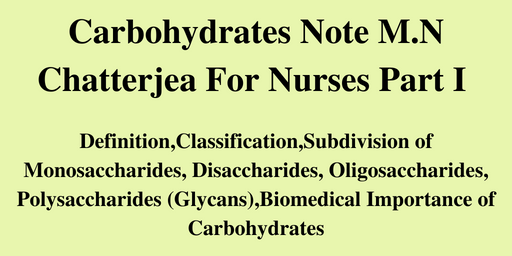The Carbohydrates Notes M.N Chatterjea For Nurses Part I a comprehensive approach. Carbohydrates are a large group of organic compounds consisting of carbon, hydrogen, and oxygen. Monosaccharides, Disaccharides
Carbohydrates Notes M.N Chatterjea Definition
Carbohydrates are essential biomolecules that serve various functions in the body, primarily as a source of energy. Chemically, they are defined as aldehyde or ketone derivatives of higher polyhydric alcohols. More specifically, they are compounds that yield these derivatives upon hydrolysis. Carbohydrates are integral to many physiological processes, and understanding their structure and function is vital for nursing practice.
Classification
Carbohydrates can be classified into four primary groups based on their structure and complexity:
- Monosaccharides
- Disaccharides
- Oligosaccharides
- Polysaccharides
1. Monosaccharides
Monosaccharides, often referred to as “simple sugars,” are the most basic form of carbohydrates. They cannot be hydrolyzed into simpler sugars and serve as the fundamental building blocks for more complex carbohydrates.
- General Formula: CₙH₂ₙOₙ
Subdivision of Monosaccharides
Monosaccharides can be further categorized based on two criteria:
- Number of Carbon Atoms: Monosaccharides are classified as trioses (3 carbons), tetroses (4 carbons), pentoses (5 carbons), hexoses (6 carbons), etc.
- Functional Group: Monosaccharides are classified as aldoses (containing aldehyde groups, -CHO) or ketoses (containing ketone groups, -CO).
| Sr. No | General Formula | Name Based on Carbon Atoms | Aldehyde or Aldo Sugars | Ketone or Keto Sugars |
|---|---|---|---|---|
| 01 | C₃H₆O₃ | Trioses | Glyceraldehyde | Dihydroxyacetone |
| 02 | C₄H₈O₄ | Tetroses | Erythrose | Erythrulose |
| 03 | C₅H₁₀O₅ | Pentoses | Ribose | Ribulose |
| 04 | C₆H₁₂O₆ | Hexoses | Glucose | Fructose |
2. Disaccharides
Disaccharides consist of two monosaccharide molecules linked together. When hydrolyzed, they yield two molecules of the same or different monosaccharides.
- General Formula: Cₙ(H₂O)ₙ₋₁
Examples of Disaccharides
- Maltose: Composed of two glucose molecules.
- Lactose: Composed of one glucose molecule and one galactose molecule.
- Sucrose: Composed of one glucose molecule and one fructose molecule.
- Lactulose: A keto disaccharide that has therapeutic applications.
3. Oligosaccharides
Oligosaccharides are carbohydrates that yield 3 to 10 monosaccharide units upon hydrolysis. An example is maltotriose, which consists of three glucose units.
4. Polysaccharides (Glycans)
Polysaccharides are complex carbohydrates that yield more than ten monosaccharide units on hydrolysis.
- General Formula: (C₆H₁₂O₆)ₙ
Types of Polysaccharides
Polysaccharides can be further categorized into two main groups:
- Homo-polysaccharides (Homoglycans): Composed of the same monosaccharide units. Examples include starch, glycogen, inulin, cellulose, dextrins, and dextrans.
- Hetero-polysaccharides (Heteroglycans): Composed of different monosaccharide units or their derivatives. An example is mucopolysaccharides (glycosaminoglycans).
Biomedical Importance of Carbohydrates
Carbohydrates play a vital role in human health and physiology for various reasons:
1. Primary Source of Energy
Carbohydrates are the body’s primary source of energy. They are broken down into glucose, which is used by cells for metabolic processes. This energy is crucial for maintaining bodily functions, physical activity, and overall health.
2. Structural Components
Carbohydrates are key components of various biological structures. For instance, they are integral to the formation of cell membranes and contribute to the structure of nucleic acids (like DNA and RNA) and proteins.
3. Role in Metabolism
Carbohydrates participate in numerous metabolic pathways. Their degradation products can act as “promoters” or “catalysts” in various biochemical reactions. For instance, glucose can be converted into fatty acids or amino acids, highlighting the versatility of carbohydrates in metabolism.
4. Medicinal Applications
Certain carbohydrate derivatives, such as cardiac glycosides and some antibiotics, have significant therapeutic applications. These compounds can be vital in treating various medical conditions, emphasizing the importance of carbohydrates in pharmacology.
5. Nutritional Value
Lactose, the principal sugar found in milk, is critical for nutrition, especially in infants. It aids in the absorption of calcium and supports the growth of beneficial gut bacteria.
6. Precursor for Biosynthesis
Degradation products of carbohydrates are utilized in synthesizing other biomolecules, such as fatty acids, cholesterol, and amino acids. This role is vital for maintaining cellular functions and overall metabolic health.
7. Tissue Integrity
Carbohydrates are constituents of mucopolysaccharides, which form the ground substance of mesenchymal tissues. This contributes to tissue integrity, elasticity, and overall health.
8. Metabolic Disorders
Inherited deficiencies in certain enzymes involved in carbohydrate metabolism can lead to diseases such as galactosemia, glycogen storage diseases (GSDs), and lactose intolerance. Understanding these conditions requires a solid grasp of carbohydrate biochemistry.
9. Diabetes Mellitus
Disruptions in glucose metabolism are a hallmark of diabetes mellitus, making the understanding of carbohydrates essential for effective management and treatment of the condition.
Conclusion
Carbohydrates are essential to human health, serving not only as a primary source of energy but also as crucial components in various biochemical processes. Understanding their classification, structure, and function is vital for nurses and healthcare professionals to provide informed care and patient education. As research in medical nutrition and carbohydrate biochemistry progresses, the significance of carbohydrates in health and disease continues to evolve.
Read More:
https://nurseseducator.com/didactic-and-dialectic-teaching-rationale-for-team-based-learning/
https://nurseseducator.com/high-fidelity-simulation-use-in-nursing-education/
First NCLEX Exam Center In Pakistan From Lahore (Mall of Lahore) to the Global Nursing
Categories of Journals: W, X, Y and Z Category Journal In Nursing Education
AI in Healthcare Content Creation: A Double-Edged Sword and Scary
Social Links:
https://www.facebook.com/nurseseducator/
https://www.instagram.com/nurseseducator/

I am really inspired with your writing skills and also with the
structure for your blog. Is that this a paid subject matter or did you customize it yourself?
Anyway stay up the nice quality writing, it is rare to peer
a great blog like this one these days. Madgicx!